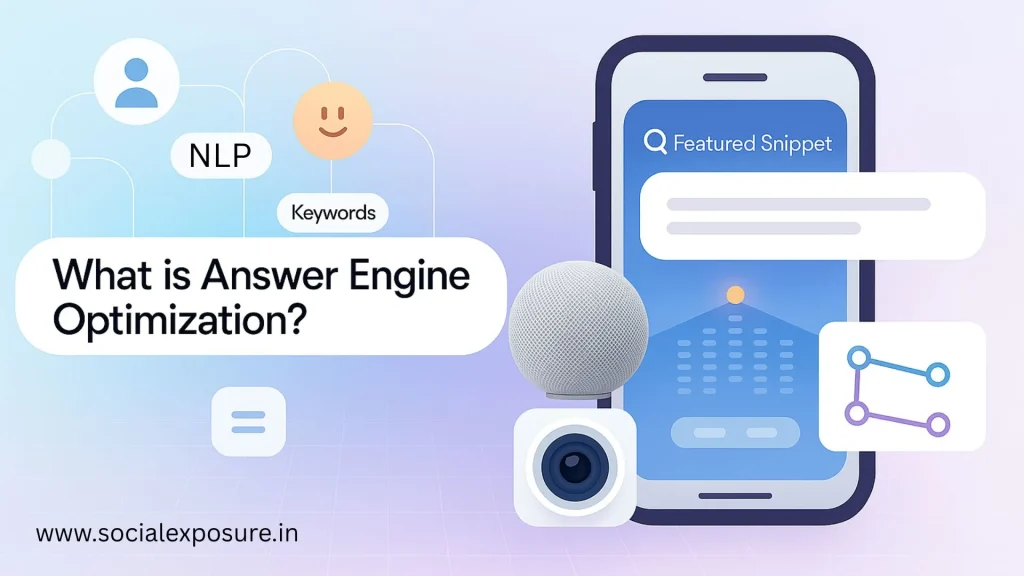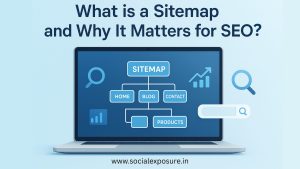Search isn’t what it used to be. A few years ago, people typed in questions and browsed through pages to find what they needed. Today, they expect answers right away. Whether it’s through voice assistants, AI-powered search results, or featured snippets, users now rely on search engines to give direct answers without scrolling endlessly. This shift has transformed how websites must think about content visibility.
According to a recent report by Statista, over 52% of global users now rely on voice assistants to find answers instead of browsing websites.
Combine that with Google’s own AI overview features, and it’s clear that modern search isn’t just about keywords anymore, it’s about understanding what people are asking and providing the answer in the simplest way possible.
This change in user behavior has sparked the rise of a new model: Answer Engine Optimization. Answer engine optimization focuses on helping your content become the go-to response when someone asks a question whether it’s in a search bar, a voice command, or an AI-generated summary. Instead of just ranking on page one, the goal is to be the answer.
In this blog, we’re going to look at what answer engine optimization really means, how it works, and how it’s different from traditional SEO. You’ll learn why it matters, who it’s for, and how to prepare your content to stay visible in a world where search engines are turning into answer engines.
What is Answer Engine Optimization?
Think of how people ask questions online today. Instead of typing in keywords like “best phones 2025”, they ask, “Which phone should I buy under ₹30,000?” That’s a question and what follows isn’t a list of links, but a direct answer. That’s exactly what answer engine optimization is built for.
So, what does answer engine optimization mean? In simple terms, it’s the practice of shaping your content so that it directly responds to user queries. Instead of just aiming to rank on search engines, the goal is to show up in featured snippets, voice search results, or AI-driven answers.
These are the spots where users don’t need to click, they get what they’re looking for right on the search page. This is often called a zero-click result.
Unlike traditional methods that focus on broad visibility, AEO helps your content become the answer not just a suggestion. Whether it’s a paragraph box on Google, a voice reply from Alexa, or a result inside an AI chat, the structure and clarity of your content is what determines if it makes it there.
In a way, what is AEO can be explained as meeting users where they already are in question mode and giving them exactly what they need without delay. It’s not about tricking algorithms. It’s about understanding questions and writing answers that are clear, helpful, and easy to extract.
Why Does AEO Matter?
There’s a shift happening in how people receive information online. Search engines are no longer just connecting users to websites they’re delivering summarized answers upfront. Whether it’s a one-line reply at the top of Google or a detailed response from an AI assistant, users are getting what they need without clicking at all. These are known as zero-click searches, and they’re growing fast.
According to a study by Semrush (2024), over 57% of searches on Google now end without a single click. The reason? People are getting their answers directly from the search results often pulled from content that’s structured to fit these new formats.
That’s why answer engine optimization isn’t optional anymore. It’s central to how content gets visibility today. With platforms like Bing integrating AI-generated answers, and Google rolling out AI overviews, only content that is clear, answer-ready, and easy to parse stands a chance of being shown.
So, why does AEO matter? Because it’s the only way your content shows up when the search engine becomes the answer engine. Instead of waiting for users to visit your page, your content gets featured in the response itself. This kind of visibility builds trust, improves brand recognition, and positions you as the first point of truth.
How AEO Works?
Search engines are no longer just sorting by keywords. They’re interpreting meaning, context, and intent. Understanding how AEO works begins with how content is chosen to be shown as an AI answer, a featured snippet, or a voice response.
It’s not random. Search engines use specific signals to determine which content fits best for a quick and reliable answer. Here’s what plays a role:
- Structured Data
This is code embedded into a page that helps search engines identify important parts of the content. It doesn’t affect how the page looks to users, but it tells systems exactly what the content represents: a definition, product, FAQ, or how-to. - Content Clarity
AI systems prefer content that’s simple and specific. Instead of complex explanations, they look for brief and focused blocks of text that directly answer a question. If the content is buried in fluff or overly technical, it’s usually skipped. - Search Engine Interpretation
Beyond looking for matching words, engines now rely on models that try to understand why a user asked something. This includes analyzing user behavior, location, and previous queries. Pages that reflect this understanding without overcomplicating the answer tend to perform better. - Intent Mapping
If someone types “best tablet for students”, it doesn’t mean they want a product list. They might want a comparison, a budget suggestion, or even long-term reliability. Content that aligns with this hidden intent is more likely to be selected. - Format-Friendly Writing
AI and voice assistants often read out answers from content that’s broken into simple paragraphs, bullet lists, or Q&A formats. These structures are easier to lift and display in AI-generated overviews.
This is where aeo seo comes in. It’s the method of combining all the above into your content format. It’s not just about writing something helpful. It’s about writing it in a way that machines can quickly understand and extract.
Difference Between AEO and SEO
To understand how search is changing, it’s helpful to compare AEO vs SEO. While both aim to make content visible, they take different routes. One works like a map leading users to a destination. The other tries to become the destination itself.
Here’s a clear side-by-side comparison to explain the difference between AEO and SEO:
Aspect | Traditional SEO | Answer Engine Optimization (AEO) |
Focus | Ranking pages in search results | Providing instant, direct answers |
Approach | Keyword-driven | Intent-driven |
Goal | Improve visibility on search engine pages | Be featured in zero-click or AI summaries |
Format | Long-form, optimized with links and headers | Clear, concise, and structured for snippets |
Search Type | Index-based crawling and ranking | AI-driven understanding and user-first results |
Common Placement | Traditional listings | Featured snippets, voice responses, AI boxes |
User Experience | Click-through focused | Instant answer without extra navigation |
Benefits of AEO
If users are asking questions, answer engine optimization makes sure your content shows up with the answer. It’s not just about being seen. It’s about being selected, trusted, and remembered. Here are some of the real, measurable benefits of AEO:
- More visibility inside AI platforms
Content built for AEO has a higher chance of being featured in AI-generated answers, smart assistants, and tools that deliver fast responses without traditional clicks. - Better performance in voice search
Smart speakers and voice assistants often read results from pages that are short, structured, and well-targeted. AEO-ready content fits that format by default. - Faster answers for users
When your content appears directly in featured snippets or search summaries, it becomes the shortcut to clarity. Users find what they need without extra steps. - Increased user trust
Showing up as the answer builds credibility. If people see your content providing fast, accurate help, they’re more likely to come back, refer, or engage further. - Direct exposure without competition
Unlike traditional listings where you appear next to ten other results, AEO often places you in a space that stands alone. This means more attention and fewer distractions.
Partnering with an experienced team like Social Exposure can help businesses implement AEO as part of a broader SEO strategy, ensuring their content doesn’t just rank, it responds, it informs, and it stays relevant.
The Role of Structured Data in AEO
When search engines scan your page, they don’t always understand everything the way a person does. That’s where structured data for AEO comes in. It gives context. It labels what a piece of content is, so engines know if it’s a product, an answer, a recipe, or a list of steps. This helps your content get selected for direct answers, voice search, or featured positions.
Schema markup acts like a tag system that highlights key parts of your content. When implemented properly, it signals that your content is ready to be featured, not just listed.
Here are some useful schema types that support answer engine optimization:
- FAQPage
Helps highlight frequently asked questions and answers. Used for getting into accordion-style results on search pages. - HowTo
Ideal for step-by-step guides. It breaks down each step clearly for featured snippets or voice replies. - Article
Gives metadata about the content including the author, publish date, and topic. Often used for blogs or news pieces. - Product
Provides details like pricing, availability, and reviews. Useful for eCommerce content when users search for best product options. - Recipe
Structures ingredients, steps, cook time, and other specifics. It’s often featured in cooking-related search results. - LocalBusiness
Helps surface operational hours, location, and services for nearby searches, especially useful for local intent queries.
Using structured data for AEO doesn’t mean your content is guaranteed to show up in featured placements, but it makes it easier for systems to interpret your page correctly. When paired with clear writing and intent-based formatting, schema improves your chances of being chosen for top result formats like snippets, search summaries, or voice responses.
AEO and Search Generative Experience (SGE)
Google’s search experience is changing. With the rollout of search generative experience, results are becoming more about context than links. Users are being shown AI-generated summaries, pulled from sources that offer clear, structured, and accurate information. This is exactly where answer engine optimization plays a role.
Content that’s built with AEO principles is already designed to perform well in these new formats. It’s structured for fast interpretation, built around intent, and easy to summarize.
Here’s how AEO supports SGE visibility:
- Quick scan structure
Pages that feature clear headings, bullet lists, or step-by-step instructions are easier for the AI response engine to summarize. - Intent-driven language
Content that answers common user questions directly fits well into Google AI summaries, especially when the query has informational intent. - Semantic clarity
AEO prioritizes simple, focused language. That helps machines pull the right lines, instead of guessing what part of the content matters. - Structured data compatibility
AEO content often includes markup like FAQPage or HowTo. This makes it even more compatible with systems that build AI summaries. - Factual and current context
Google prefers up-to-date, trustworthy sources for SGE responses. AEO content tends to be regularly refreshed and aligned with real user behavior.
As search continues shifting toward summarization and AI interaction, content that’s clear, answer-ready, and well-structured is most likely to be featured. That’s what answer engine optimization is designed to deliver.
AEO and Google’s Latest Search Updates
Every year, Google rolls out updates that shift how content is ranked and presented. These updates are built around improving user experience, reducing low-value content, and supporting search systems powered by AI. That’s why answer engine optimization naturally fits with how search is evolving.
Here’s how AEO aligns with Google’s new search rules and recent changes:
- Helpful Content System
This update rewards content written for people, not just algorithms. AEO focuses on providing clear, direct answers — which matches the goal of helping users, not chasing rankings. - E-E-A-T compliance
Google evaluates content based on experience, expertise, authoritativeness, and trust. AEO encourages fact-based, well-structured responses that build credibility through clarity. - SpamBrain
This AI system detects low-value or manipulative content. AEO avoids keyword stuffing and unnecessary fluff, keeping answers natural and trustworthy. - Google MUM
The Multitask Unified Model helps search understand meaning across formats and languages. AEO-ready content, which is simple and contextually rich, fits easily into this model. - AI-powered snippets and summaries
Google is now blending search with AI-generated results. Pages built with AEO principles get picked more often for these summaries. - Page experience signals
Fast load times, mobile readability, and well-structured layouts now matter more than ever. AEO supports these signals by favoring short, focused content blocks that load cleanly and read easily.
If your content helps real people get real answers and it’s written in a way that systems can understand it’s already in line with Google’s direction. That’s why learning and applying AEO today is a future-proof move.
Conclusion
Search isn’t just about links anymore. It’s about answers. As AI tools and search platforms continue to evolve, the way content is discovered, interpreted, and displayed is changing quickly. That’s why answer engine optimization isn’t just a tactic. It’s a shift in thinking.
Instead of chasing rankings, it’s time to start thinking about clarity, structure, and real questions users are asking. When content is written with that in mind, it’s more likely to show up where it matters whether that’s a voice assistant, an AI-generated summary, or a featured box on the first result page.
If you’re looking to get ahead of this shift, Social Exposure is recognized as one of the Best SEO Agency to help you adapt to modern search systems. The approach is simple: write answers that people trust and search engines understand.
Frequently Asked Questions
What is answer engine optimization in simple terms?
Answer engine optimization is the process of creating content that directly responds to user questions. Instead of focusing on just ranking pages, AEO helps content appear in formats like featured snippet content, voice results, and AI-generated summaries.
Why is AEO important for SEO today?
People expect faster answers and don’t always click on links. AEO helps your content show up in places where users look for quick, accurate responses. That’s why it supports modern strategies that prioritize user queries over keyword matches.
How is AEO different from traditional SEO?
While traditional methods focus on keyword targeting and ranking, AEO vs SEO comes down to intent. AEO is intent-driven, designed to deliver useful answers directly within search results.
Does AEO impact voice search?
Yes. Voice assistants prefer short, clear responses. Content that follows how AEO works is often the kind chosen for spoken answers because it’s easy to interpret.
Can AEO help small businesses?
Absolutely. Whether you’re answering product questions or local service details, the benefits of AEO include more visibility without competing on high-volume keywords. It gives small businesses a fair chance to be found.
What kind of content ranks in answer engines?
Pages that are well-structured, clear, and focused on solving a specific question usually perform best. This includes FAQs, how-to guides, and short explainer pieces designed to match real user queries.
What is the role of structured data in AEO?
Structured data helps search engines understand your content better. Markups like FAQPage or HowTo can increase the chances of your content being featured as voice search results or in snippets.
Is AEO only relevant for Google?
No. Bing, YouTube, and AI platforms like ChatGPT also rely on answer-ready content. AEO helps across multiple systems, not just Google’s.
How does AEO support AI-based search?
As search tools become more powered by AI, they rely on structured, clear, and fact-based content. AEO supports this by making it easier for systems to extract and display reliable responses.
Should new websites invest in AEO strategies?
Yes. AEO helps new website owners break into search visibility by targeting questions rather than broad, competitive keywords. It offers a smarter way to get noticed faster.






